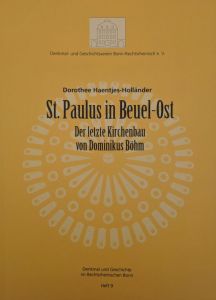
THE LAST CHURCH BUILT BY DOMINIKUS BÖHM
Details about the publication by Dorothee Haentjes-Holländer.
Bonn on the right bank of the Rhine has a building by the famous church builder Dominikus Böhm. Because it is widely unknown, the Denkmal- und Geschichtsverein Bonn-Rrh. has published a book about it: "St. Paulus in Beuel-Ost. The last church building by Dominikus Böhm". Author is the cultural historian Dorothee Haentjes-Holländer M.A. from Beuel. The richly illustrated book, about 100 pages, was published as issue 9 in the association series "Contributions to Monuments and History in Bonn on the Right Bank of the Rhine".
In the industrial area of the east of Beuel, which is on its way to becoming a new cultural quarter, the parish church of St. Paulus, inaugurated in 1958, is the last church building whose planning goes back to Dominikus Böhm. His son Gottfried completed the work. Despite its prominent location on Siegburger Straße, directly opposite the listed buildings of the former jute spinning mill (Pantheon Theatre), this place of worship is little known: It is in danger of being virtually forgotten.
And also the future of this church seems uncertain; the monument association could possibly imagine it as a central concert venue. That is why Haentjes-Holländer's monograph is all the more valuable at this time: in the 60th year of its foundation, it skilfully draws attention to this monument, which is so outstanding in terms of art history.
"The author is, of course, concerned, in addition to explaining the local and parish history of the time, with presenting the building history itself. Above all, however, she is concerned to awaken an understanding for the forms of expression of modern church building as a whole. Architecture has a direct effect on us. But not all buildings are immediately understood by us. Especially the architectural forms of modern churches are considered by many to be brittle, sober, not very appropriate.
The sensitive guidance provided by this monograph will help to build a bridge to acceptance and appreciation for an architecture that is several decades old, but not yet so old that it is already generally recognized as a historical cultural asset. The author builds this bridge for us by not only describing the architect's work, but above all by explaining the expressions of church architecture, Dominikus Böhm's system of signs, and by addressing its impact.
In doing so, she always has the interactions of architecture and spirituality in mind and thus does justice to the claim that Dominikus Böhm in particular made on himself. Thus the church is interpreted by her, as it were, as the keystone in Dominikus Böhm's overall oeuvre, holding everything together and summarizing it, and best understood in conjunction with the whole." (Dr. M. Bredenbeck, Foreword)

